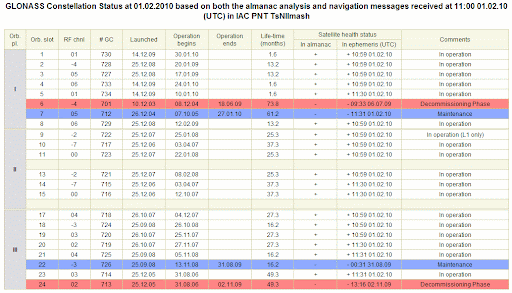- Joined
- Feb 13, 2008
- Messages
- 5,398
- Reaction score
- 8
- Points
- 0
- Location
- Khimki
- Website
- tigerofsiberia.livejournal.com
This topic is to keep track after how well GLONASS system is getting to its full complement. According to the latest promise, it's going to reach the full availability in the end of 2010.
The previous peak was reached in 1995 with the old Uragan type spacecrafts, just simultaneously with the outbreak of complete slackening the reins in Russian economy by the government (see the graph).

In 2000's, a new 2nd generation Uragan-M sats with extended lifetime were introduced, but their reliability had not been satisfactory just enough to balance between the constellation decay and launch rates, most of the time keeping the number of operational satellites between 10 and 16.
Also, not much of civilian Glonass receiving hardware and maps were available on the market before 2008 (and that's why the system still doesn't sell very good).
Before the launch of December 19, 2009 the numbers were:


As of today, all of the launched satellites (730, 733, 734) have been commissioned. However, #713 has been moved into decommission state from maintenance and #712 has been put out of operation for maintenance:


The current plans are to launch two Uragan-M triplets on March 2, 2010 and on some day in August; in November, a 1st test article of the new Uragan-K satellite will accompany two Uragan-M in a single launch on Proton. This is going to fill the constellation to the full capacity (24 satellites in 3 planes).
For 2011, two triplet launches on Proton are planned to fight against the expected decay rate.
The previous peak was reached in 1995 with the old Uragan type spacecrafts, just simultaneously with the outbreak of complete slackening the reins in Russian economy by the government (see the graph).

In 2000's, a new 2nd generation Uragan-M sats with extended lifetime were introduced, but their reliability had not been satisfactory just enough to balance between the constellation decay and launch rates, most of the time keeping the number of operational satellites between 10 and 16.
Also, not much of civilian Glonass receiving hardware and maps were available on the market before 2008 (and that's why the system still doesn't sell very good).
Before the launch of December 19, 2009 the numbers were:


As of today, all of the launched satellites (730, 733, 734) have been commissioned. However, #713 has been moved into decommission state from maintenance and #712 has been put out of operation for maintenance:


The current plans are to launch two Uragan-M triplets on March 2, 2010 and on some day in August; in November, a 1st test article of the new Uragan-K satellite will accompany two Uragan-M in a single launch on Proton. This is going to fill the constellation to the full capacity (24 satellites in 3 planes).
For 2011, two triplet launches on Proton are planned to fight against the expected decay rate.





